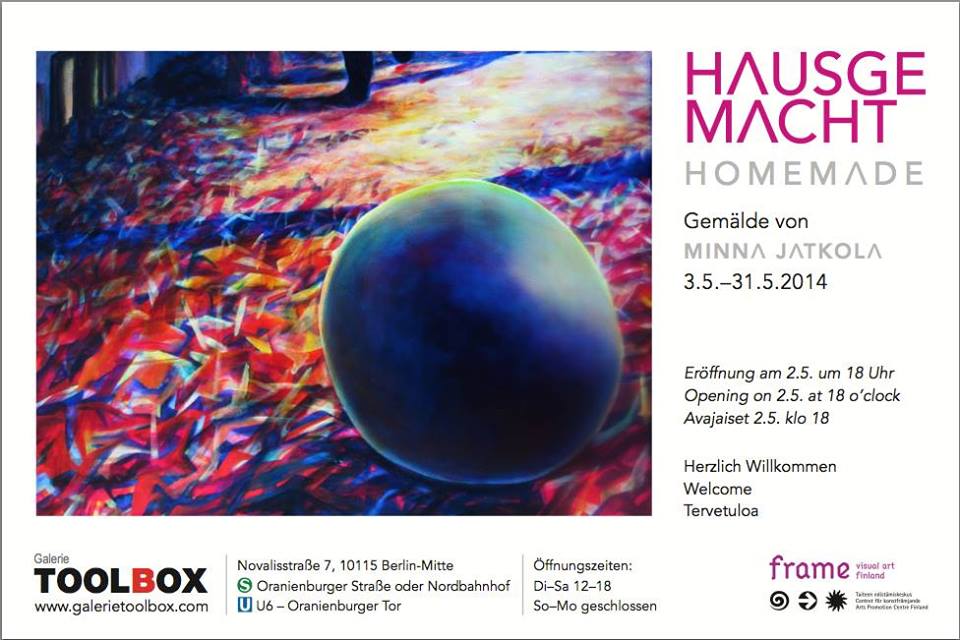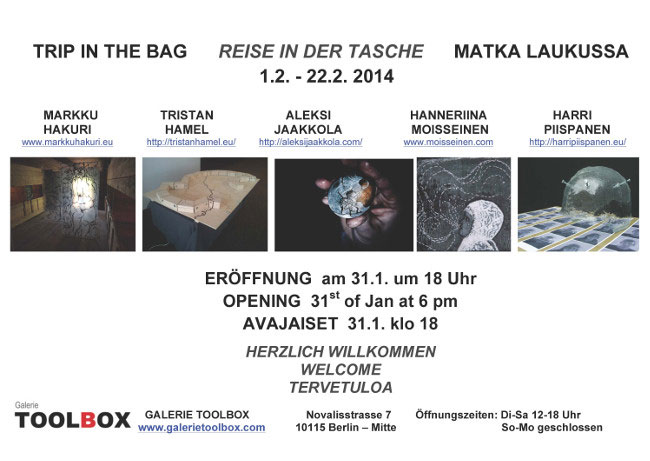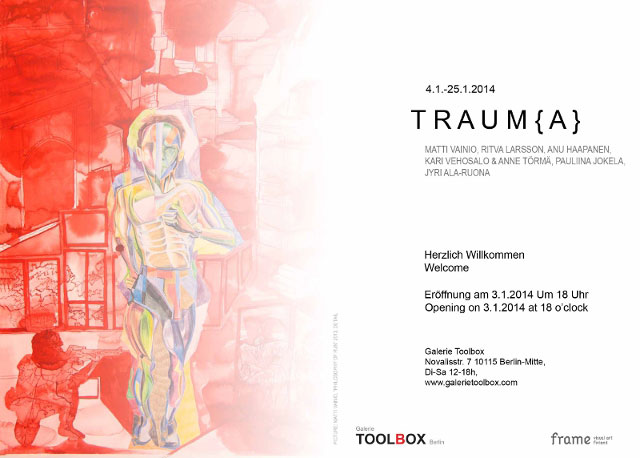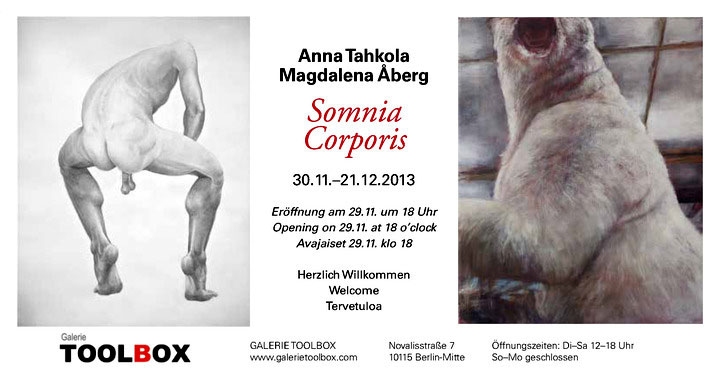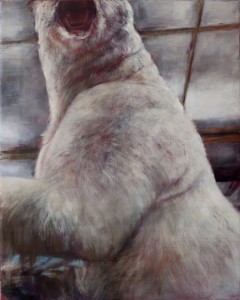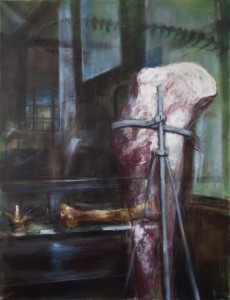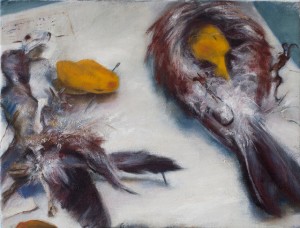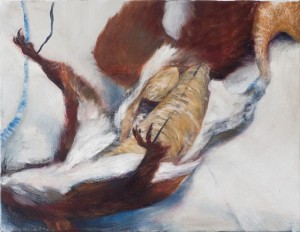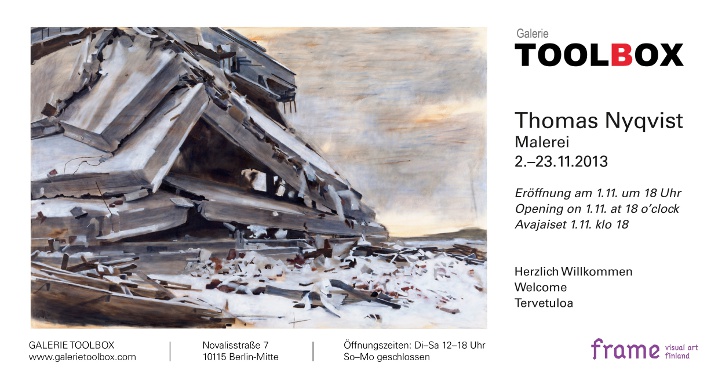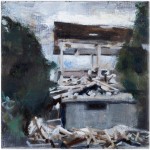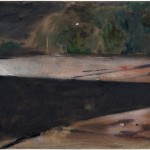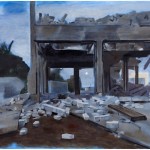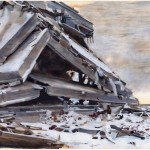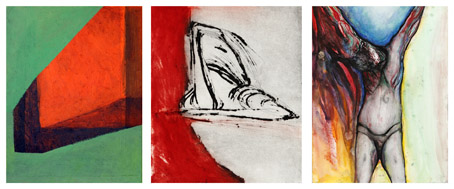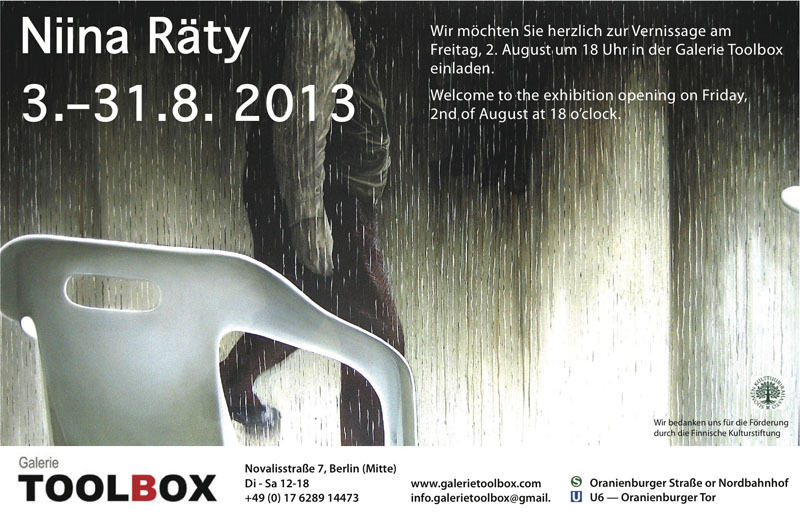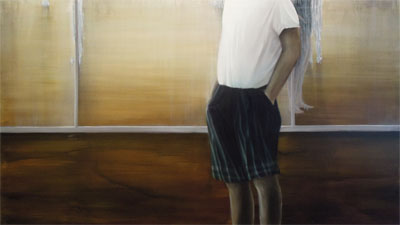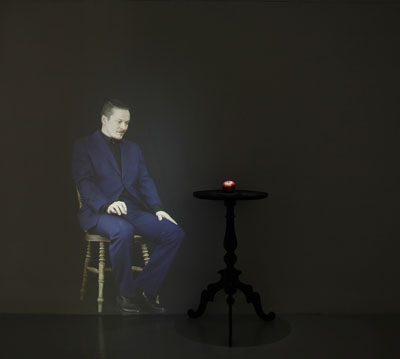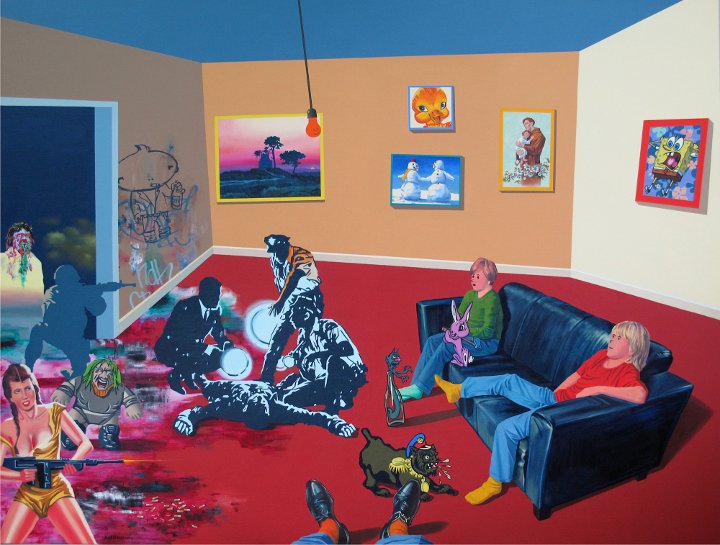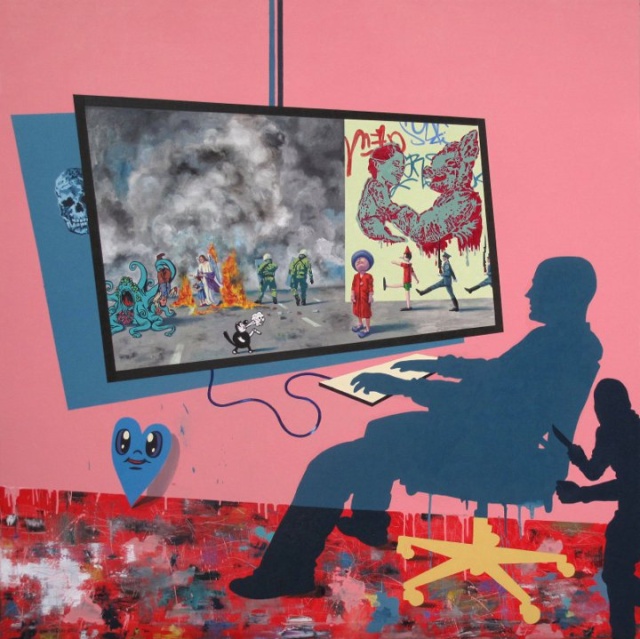All posts tagged “Painting”
Trip in the Bag | 1.–22.2.2014
he metamorphoses of a bag and its content to an installation, February 1st – February 22nd, 2014
Opening January 31st.
Artists’ homepages: Markku Hakuri, Tristan Hamel, Aleksi Jaakkola, Hanneriina Moisseinen, Harri Piispanen
Traum{a} | 4.–25.1. 2014
Vernissage January 3rd.
Artists’ homepages: Anu Haapanen, Jyri Ala-Ruona, Kari Vehosalo, Anne Törmä, Ritva Larsson, Matti Vainio
Anna Tahkola & Magdalena Åberg:
Somnia Corporis | 30.11.–21.12.2013
Drawings and paintings
Opening 29.11.2013 at 18 o’clock
Somnia Corporis – körperliche Träume geben den menschlichen Naturkräften, Bedürfnissen und Ängsten ihre Form.
Träume sind nicht nur Träume, sondern auch Phantasien, Vorstellungen, Erwartungen und Ansichten über die Welt. Dies sind physische Gefühle, denn Träumen ist eine physische Eigenschaft. Wie der französische Philosoph Jean-Luc Nancy schreibt:
“Wenn der Körper im Denken begriffen ist, dann zwingt der Körper das Denken dahin, immer weiter, immer zu lang – zu weit, als dass das Denken bloßes Denken bliebe, aber nie so weit, dass es sich materialisieren würde. Deshalb wäre es sinnlos vom Körper und vom Denken als voneinander getrennten Dingen zu reden, als könnten sie je getrennt werden: Sie sind einander die Berührung, in der der eine sich in dem anderen bricht und umgekehrt. Diese Berührung ist die Grenze, der Zwischenraum des Seins. Dennoch hat er einen Namen: Glück, und Leid und Schmerz.”
Die Werke der Ausstellung erzählen von der Möglichkeit und Unmöglichkeit des Seins. Der Genuss im Werk erstarrt unlösbar im unbewegten Bild, in der Haltung des Menschen, des Tieres in seiner natürlichen oder ausgestopften Form, im Ausdruck der Lust oder der Angst.
Der Mensch des Westens lebt als organische Gestalt in einer Welt aufgebauter Strukturen, die sich verändert, reagiert, (er)lebt, kämpft und vermodert. Unter allen polierten und glatten Oberflächen der Gesellschaft schwelt die Sehnsucht nach der Natur außerhalb der Zivilisation. Einer Natur, die in uns allen noch weiterlebt.
Magdalena Åberg (geb.1972) und Anna Tahkola (geb. 1983) sind bildende Künstlerinnen aus Helsinki. In den Gemälden Åbergs kommt das Verhältnis zwischen Mensch und Umgebung in blitzähnlichen Bildern zum Ausdruck. In Tahkolas Bleistiftwerken stellt die Form der Natur und die Stellung des Menschen in Bezug auf die Welt den Ausgangspunkt dar. Unter Zuhilfenahme von Formen beschäftigen sich die Werke beider Künstlerinnen mit Widersprüchen. Aus diesen Widersprüchen entsteht eine Energie, die sich von Innen heraus öffnet, um zu barer Form zu gelangen.
Somnia corporis – Ruumiilliset unelmat antavat muodon ihmisen luonnonvoimille, tarpeille ja peloille.
Unelmat eivät ole vain unia, vaan myös mielikuvia, odotuksia ja käsityksiä maailmasta. Ne ovat fyysisiä tunteita, sillä unelmoiminen on ruumiin ominaisuus. Kuten ranskalainen filosofi Jean-Luc Nancy kirjoittaa:
“Ruumiin ajattelussa ruumis pakottaa ajattelun yhä pidemmälle, aina liian kauan – liian pitkälle, että ajattelu pysyisi ajatteluna, muttei koskaan niin pitkälle, että siitä tulisi ruumis. Sen takia ei ole mieltä puhua erikseen ruumiista ja ajattelusta, ikään kuin ne voisivat olla jotenkin erillään: ne eivät ole kuin toinen toisensa kosketus, jossa yksi murtaa toisen ja murtuu toiseksi. Tämä kosketus on raja, olemassa olon välitila. Silti sillä on nimi: ‘ilo’ ja ‘tuska’ tai ‘kipu’.”
Näyttelyn teokset kertovat olemassaolon mahdollisuuksista ja mahdottomuudesta. Teoksissa nautinto jähmettyy ratkaisemattomaksi liikkumattomassa kuvassa, ihmisen, luonnonmuodon tai täytetyn eläimen asennossa, halun ja pelon ilmeissä.
Länsimainen ihminen elää rakennetun järjestyksen maailmassa orgaanisena muotona, joka muuttuu, reagoi, nauttii, kamppailee ja maatuu. Yhteiskunnan kaikkien kiillotettujen, sileiden pintojen alla piilee kaipuu sivilisaation ulkopuolella olevaan luontoon. Luontoon, joka meissä kaikissa on vielä jäljellä.
Magdalena Åberg (s.1972) ja Anna Tahkola (s. 1983) ovat helsinkiläisiä kuvataiteilijoita. Åbergin maalauksissa ihmisen ja ympäristön suhde valottuu välähdyksenomaisina kuvina. Tahkolan lyijykynäteoksissa lähtökohtana on luonnon muoto tai ihmisen asento suhteessa maailmaan. Molempien taiteilijoiden teokset tutkivat muotojen kautta sitä, mikä on ristiriitaista. Ristiriidasta syntyy energiaa, joka aukeaa sisältäpäin saavuttaakseen paljaimman muotonsa.
Thomas Nyqvist: Paintings
2.–23.11-2014
Vernissage November 1st, 18 o’clock
In seiner Kunst stellt Thomas Nyqvist die Frage: was bedeuten Marginalien und Ruinen für die Lebenswelt des Menschen? Der Ausgangspunkt für sein Werk ist der Abriss von Industriegebäuden in seiner Heimatstadt Helsinki. Er gestaltet diese Gebäude wie gefundene Ruinen, der Abriss und seine Mechanismen werden ausgelassen. Was bleibt ist ein Objekt, das sich der Kategorie Ruine zuordnet. Nyqvists Hintergrund im abstrakten Expressionismus wird in den Ruinemotiven deutlich, bei welchen es sich sowohl in Hinsicht auf den Inhalt als auf die Form um einen Kampf zwischen Bau und Zerstörung, Ordnung und Chaos handelt.
In his paintings Thomas Nyqvist poses a question concerning the meaning of ruins and margins in the human world. The starting point for his work is the tearing down of industrial buildings in his native city, Helsinki. In the paintings the buildings are shown as ‘found’ ruins, and the actual process of demolishing and its mechanisms are effaced. What is left is an object, which belongs to the category of ruin. His background in Abstract Expressionism asserts itself in these ruin motifs, which deal – both in content and formally – with the struggle between building and dilapidation, and between order and chaos.
Beauty Box
7.–28.9.2013
Robin Lindqvist, Veronika Ringbom,
Henry Wuorila-Stenberg
Robin Lindqvist: Unknown Object, 2013, oil on canvas Veronika Ringbom: Sanguinario, 2012, carborundum and drypoint Henry Wuorila-Stenberg: Christ, 2012, watercolor
Three very different artists, Robin Lindqvist, Veronika Ringbom and Henry Wuorila-Stenberg show paintings, prints and drawings. Artist and curator Jan Kenneth Weckman ties the works together by suggesting, if these works can be investigated in the light of beauty? The distance between the proposal and works might also be transformed in to a question about the being of beauty.
Is it a question about the beautiful, the way all kinds of things may be displayed, or are we able to talk about beauty as a thought, a goal or as an ethos (in art as well)?
The exhibition does not give answers, only builds a space for inquiry, in which we take up a position, each one on our own, like the light, that floods on the work. What do we see, if we ask about beauty in art and in life?
More information about the artists:
Robin Lindqvist (PDF)
Veronika Ringbom (PDF)
Henry Wuorila-Stenberg (PDF)
Read more about the proposal and discussion around the idea of beauty and contemporary art here. (PDF)
Niina Räty
3.–31.8.2013
Exhibition opening 2nd of August at 18 o’clock.
Welcome!
Niina Räty: At the Beach, Tero 2008, 2013, Oil on linen
“I mostly paint large multi-part series of works.”
“I create my own photo album via painting, depicting close people and places as seen through my own experiences. I seek the things that life and existence attach to. I choose a situation or a space that is private and universal like a family gathering, holiday in a summer cottage or a plate on a kitchen table. In my paintings, just like in front of a camera there is a composition; a wedding couple just like other wedding couples around the world, a tourist in front of a local sight forms a picture – a composition that we all are familiar with from our own holiday photos.”
“We try to capture important moments in our own album and as we take the pictures they represent the form of the event. Compositions using this formula illustrate our own life story. Perhaps through these mechanics of social and spatial being we have a fleeting chance of understanding other people.”
Minna Jatkola & Juhana Moisander
29.6.–27.7.2013
Juhana Moisander: The Temptation, 2012 video projection, table, apple
Installations & Paintings
Press Release in English (pdf)
Pressemitteilung auf Deutsch (pdf)
Juha Sääski: Tragikomisch
27.4.–25.5.2013
Juha Sääski portraitiert in seinen Gemälden den Zeitgeist. Das Leben der Menschen in der westlichen Gesellschaft scheint zunehmend durch Entfremdung und strukturelle Gewalt gekennzeichnet zu sein. Aspekte wie Unterhaltungswert und Pornographie erlangen in unserer Leitkultur einen immer höheren Stellenwert und verschleiern gleichermaßen Begegnungen mit der Wirklichkeit. Unterstützt wird diese Verschleierung auch mit Hilfe der Weltanschauung politischer und wirtschaftlicher Macht, die durch die Medien verbreitet wird.
Einer der zentralen Aspekte in Juha Sääskis Werken ist die Darstellung der tragikomischen und paradoxen Seiten menschlichen Lebens. Zur Veranschaulichung seiner Beobachtungen bedient sich Sääski einer Vielzahl von Stilmitteln: Entfremdung, Humor, Satire und Parodie. Naive und vereinfachende Aussagen, Klischee, die Darstellung positiver und optimistischer Dinge, moderne Ästhetik, Straßenkunst und Figuren der Populärkultur werden ernsten und traurigen Themen gegenübergestellt. Die treibende Kräfte in Sääskis Werken sind Mitgefühl und Hoffnung. Durch die Verknüpfung widersprüchlicher Elemente schafft Juha Sääski Einheiten, in denen selbst absurde Assoziationen uns nicht von der Wirklichkeit entfremden, sondern im Gegenteil neue Blickwinkel eröffnen und uns die wahre Natur von Dingen und Phänomenen reiner und deutlicher vor Augen führen.
Juha Sääski ist ein finnischer Künstler, der außer in Finnland auch an einer Anzahl von Gruppen- und Gemeinschaftsausstellungen, sowie an Einzelausstellungen in verschiedenen Ländern Europas teilgenommen hat. Zuletzt war er überwiegend in Deutschland zu sehen, wie z.B. mit der finnisch-zeitgenössischen Ausstellung ”Memory traces” im Ludwig Museum in Koblenz und Berlin, sowie in Gruppenausstellungen in München und Berlin, in Einzelausstellungen in Ulm und Nürnberg und jetzt in der Galerie Toolbox, in Berlin.
Katalog erhältlich.
Zusätzliche Informationen unter Registry of Finnish Artists — Kuvataiteilijamatrikkeli
Juha Sääski | Tragicomic
In his paintings Juha Sääski is sketching a portrait of the spirit of time. The life of humans in the Western World can be depicted as increasingly estranged and suffering from the structural violence of society and market economy. The prospering entertainment- and porn-like main culture is working as a smoke-screen in reality-meeting situations. This enstragement is supported by the world-view of the political and economical power which is spread by the media.
The basic emotional setting in Juha Sääski´s works is often the tragicomic and paradoxal nature of human life. Sääski shows his perceptions by alienation, humor, satire and parody. He is contrasting naïve and simplifying statements, cliches, happy or optimistic things, modern aesthetics, street art and figures of popular culture with serious and sad subject matters. Symphathy and hope are Sääski´s driving forces.
By combining tragicomic and conflicting elements Juha Sääski is constructing entities, where even absurd associations do not alienate us from meeting reality, but might open new perspectives and show the true nature of subjects and phenomena more clealry and purely.
Juha Sääski is a Finnish visual artist, who, apart from his work in Finland, has participated in many group and solo exhibitions throughout Europe. His recent shows were predominantly in Germany, as for instance the Finnish contemporary exhibition ”Memory Traces” in Ludwig-Museum in Koblenz, and Berlin. Further, he was seen in group exhibitions in Munich and Berlin, in solo shows in Ulm and Nuremberg and now in Galerie TOOLBOX in Berlin. C
Catalogue available.
More information: Registry of Finnish Artists — Kuvataiteilijamatrikkeli
Social isolation, 13.10.–10.11. 2012
The exhibition was preceded by an international workshop between the participating artists Maiju Heikkilä (Fin), Anna Tahkola (Fin), Elisabeth Buset (Can), Janne Kärkkäinen (Fin), Sampsa Ingren (Fin), Jonna Sivonen (Fin), Anne Rossi (Fin), Erkki Nampajärvi (Fin), Matti Vainio (Fin) and Annika Bergvik‑Forsander (Fin)
Social Isolation
Social Isolation, the second exhibition of the new Berlin based art gallery Galerie TOOLBOX, consists of drawings by ten young artists discussing themes of social alienation from a variety of perspectives. The exhibition is based on a concentrated drawing workshop occurring in the gallery, during which every artist implements one work and participates in the creation of one collective work.
The exhibition approaches the social aspects of modern culture from the concept of alienation. What does alienation mean in modern Europe? How can it be treated with the means of art?
The idea of social alienation originates from the philosophy of Georg Hegel (1770–1831). The term of alienation has been especially connected with the theory of Karl Marx. It is one of the most used theories in social sciences and also in modern art.
Alienation deals with the vanishing of human and natural values in a fragmented and objectified social reality. The working culture, with its emphasis on competitiveness, also escalates social relations. The meaning of human dignity and labour is blurred, when man is above all required to conform to be a part of machinery. The satisfaction of understanding totalities, like finishing a work from beginning to end, is a natural human desire. The structural violence of the society, such as fragmentation that creates weakness or connecting human dignity to the ideal of productivity alienates man from nature, other people, his or her own feelings and needs. We require a human dignity that is independent of economy, production and consumption, a freedom to a more comprehensive life in order to be able to recognize man and nature in connection to us, belonging to our own humanity.
Social Isolation brings artists used to independent and lonely work, to work in a commonly shared space. The exhibition and workshop enable the sharing of art and work, and the joy of producing a work from beginning to end.
Artists of exhibition are Maiju Heikkilä (Fin), Anna Tahkola (Fin), Elisabeth Buset (Can), Janne Kärkkäinen (Fin), Sampsa Indgrén (Fin), Jonna Sivonen (Fin), Anne Rossi (Fin), Erkki Nampajärvi (Fin), Matti Vainio (Fin) ja Annika Bergvik-Forsander (Fin).
Galerie TOOLBOX is a cooperative of seven Finnish artists in the centre of Berlin, in Mitte. The gallery represents Finnish and international art from the perspective of social questions.
Social Isolation
Uuden berliiniläisen Galerie TOOLBOXin toinen näyttely Social Isolation koostuu 10 nuoren taiteilijan teoksista, jotka käsittelevät sosiaalisen eristäytymisen teemoja eri näkökulmista. Näyttelyn pohjana on gallerian tiloissa järjestettävä piirustusworkshop, jonka aikana kukin taiteilijoista toteuttaa yhden teoksen ja osallistuu yhden yhteisteoksen tekemiseen.
Näyttely lähestyy nykykulttuurin sosiaalisia näkökulmia vieraantumisen käsitteestä käsin. Mitä vieraantuneisuus tarkoittaa nyky-Euroopassa? Miten sitä voi käsitellä taiteen keinoin?
Alkujaan ajatus yhteiskunnallisesta vieraantumisesta tulee saksalaisen Georg Hegelin (1770 – 1831) filosofiasta. Vieraantuneisuuden termi on myöhemmin liitetty etenkin Karl Marxin teoriaan. Se on yksi käytetyimmistä teorioista yhteiskuntapolitiikassa ja myös nykytaiteessa.
Vieraantuneisuudessa on kysymys inhimillisten ja luonnollisten arvojen katoamisesta sirpaloituneessa ja esineellistetyssä yhteiskunnallisessa toiminnassa. Kilpailukykyä korostava työkulttuuri laajenee koskemaan myös sosiaalisia suhteita. Niin ihmisarvon kuin työnkin merkitys hämärtyy, kun ihmiseltä vaaditaan ennen kaikkea sopimista koneiston osaksi. Kokonaisuuksien ymmärtämisen, niin kuin työn alusta loppuun saattamisen nautinto on ihmiselle luonnollinen, inhimillinen tarve. Yhteiskunnan rakenteellinen väkivaltaisuus, kuten voimattomuutta aiheuttava sirpaleisuus tai ihmisarvon sitominen tuottavuuden ideaaliin vieraannuttaa ihmistä luonnosta, toisista ihmisistä, omista tunteistaan ja tarpeistaan. Tarvitsemme taloudesta, tuotannosta ja kuluttamisesta vapaata ihmisarvoa, vapautta kokonaisvaltaisempaan elämään, jotta voisimme tunnistaa ihmisen ja ympäristön luonnollisesti meihin liittyviksi, omaan ihmisyyteemme kuuluviksi.
Social Isolation tuo itsenäiseen ja yksinäiseen työhön tottuneet taiteilijat työskentelemään yhteisesti jaettuun tilaan. Näyttely ja workshop mahdollistaa taiteen ja työn jakamisen, sekä alusta loppuun asti valmistuvan työn tekemisen ilon.
Näyttelyn taiteilijat ovat Maiju Heikkilä (Fin), Anna Tahkola (Fin), Elisabeth Buset (Can), Janne Kärkkäinen (Fin), Sampsa Indgrén (Fin), Jonna Sivonen (Fin), Anne Rossi (Fin), Erkki Nampajärvi (Fin), Matti Vainio (Fin) ja Annika Bergvik-Forsander (Fin). Workshopin ja näyttelyn tutorina toimii kuvataiteilija Mika Karhu. Lisäksi workshopissa luennoi filosofi FT Pentti Määttänen.
Galerie TOOLBOX on seitsemän suomalaisen kuvataiteilijan ylläpitämä galleria Berliinin keskustassa, Mittessä. Galleria esittelee suomalaista ja kansainvälistä taidetta yhteiskunnallisten ja sosiaalisten kysymysten tiimoilta.
